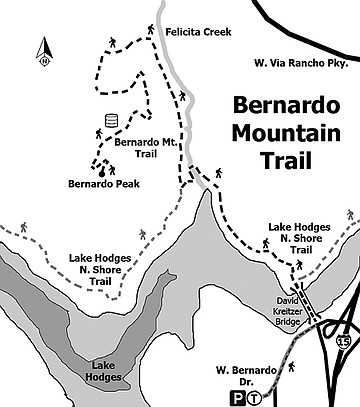 Facebook
Facebook
 X
X
 Instagram
Instagram
 TikTok
TikTok
 Youtube
Youtube


Bernardo Mountain, with an elevation of 1150 feet, rises steeply from the north shore of Lake Hodges, southwest of Escondido. It offers a relatively short, vigorous hike to the peak for dramatic views of this rapidly expanding part of North County as well as Lake Hodges. Also, in non-drought years when the Lake Hodges east arm has open water, the birding opportunities are extraordinary. This is an offshoot of the Coast to Crest San Dieguito River Park trail system and is a popular weekend trail.
From the Piedras Pintadas parking lot, walk down the sidewalk on the north side of W. Bernardo Dr. to the David Kreitzer Bicycle/Pedestrian Bridge crossing for the now-dry east arm of Lake Hodges. In years with adequate rainfall, when there is water under the bridge, there is easy viewing proximity to the colorful array of migratory waterfowl that visit Lake Hodges in fall and spring. Unfortunately, in the current drought, you can’t even see the water, let alone the birds, from the bridge.
Once across the bridge, go west (left) on the well-trodden dirt trail along the north shore. In about half a mile the trail turns to the north as it crosses Felicita Creek, a perennial stream, largely due to urban runoff. Although it has some of the attributes of a native San Diego watercourse, the canyon has an abundance of water-loving invasive plants, especially Mexican fan palms, Canary Island date palms, and tamarisk. However, coast live oaks, sycamores, willows, and poison oak also are abundant here. Native wild grape vines also hang from some of the trees.
The trip along the verdant riparian habitat along the stream is short, and in another 0.2 mile the Bernardo Mountain Trail splits off to the right and begins its fairly gentle ascent through coastal sage scrub up to the peak. For nearly a mile the trail is above Felicita Creek but not under the shady trees along the stream. Then the trail turns west, and with a few switchbacks, the trail goes past a water-storage tank and up to the peak. Whenever another trail splits off from The Bernardo Mountain Trail, stay to the left. After enjoying the extraordinary views from the top, return the way you came.
Bernardo Mountain is a good place to observe the physiological responses of native shrubs to drought. Even in early June 2014, the black sage had lost most of its leaves, a normal response of this plant to our rainless summers, but usually occurring much later in the year. Also, most of the individual black sage plants did not bloom or bloomed only weakly in 2014, so it may be difficult to recognize them. Mission manzanita plants have retained their leaves, but very few berries resulted from their fall flowers. Laurel sumac plants have much smaller leaves than normal for this species, and many individuals are not flowering.



Bernardo Mountain, with an elevation of 1150 feet, rises steeply from the north shore of Lake Hodges, southwest of Escondido. It offers a relatively short, vigorous hike to the peak for dramatic views of this rapidly expanding part of North County as well as Lake Hodges. Also, in non-drought years when the Lake Hodges east arm has open water, the birding opportunities are extraordinary. This is an offshoot of the Coast to Crest San Dieguito River Park trail system and is a popular weekend trail.
From the Piedras Pintadas parking lot, walk down the sidewalk on the north side of W. Bernardo Dr. to the David Kreitzer Bicycle/Pedestrian Bridge crossing for the now-dry east arm of Lake Hodges. In years with adequate rainfall, when there is water under the bridge, there is easy viewing proximity to the colorful array of migratory waterfowl that visit Lake Hodges in fall and spring. Unfortunately, in the current drought, you can’t even see the water, let alone the birds, from the bridge.
Once across the bridge, go west (left) on the well-trodden dirt trail along the north shore. In about half a mile the trail turns to the north as it crosses Felicita Creek, a perennial stream, largely due to urban runoff. Although it has some of the attributes of a native San Diego watercourse, the canyon has an abundance of water-loving invasive plants, especially Mexican fan palms, Canary Island date palms, and tamarisk. However, coast live oaks, sycamores, willows, and poison oak also are abundant here. Native wild grape vines also hang from some of the trees.
The trip along the verdant riparian habitat along the stream is short, and in another 0.2 mile the Bernardo Mountain Trail splits off to the right and begins its fairly gentle ascent through coastal sage scrub up to the peak. For nearly a mile the trail is above Felicita Creek but not under the shady trees along the stream. Then the trail turns west, and with a few switchbacks, the trail goes past a water-storage tank and up to the peak. Whenever another trail splits off from The Bernardo Mountain Trail, stay to the left. After enjoying the extraordinary views from the top, return the way you came.
Bernardo Mountain is a good place to observe the physiological responses of native shrubs to drought. Even in early June 2014, the black sage had lost most of its leaves, a normal response of this plant to our rainless summers, but usually occurring much later in the year. Also, most of the individual black sage plants did not bloom or bloomed only weakly in 2014, so it may be difficult to recognize them. Mission manzanita plants have retained their leaves, but very few berries resulted from their fall flowers. Laurel sumac plants have much smaller leaves than normal for this species, and many individuals are not flowering.